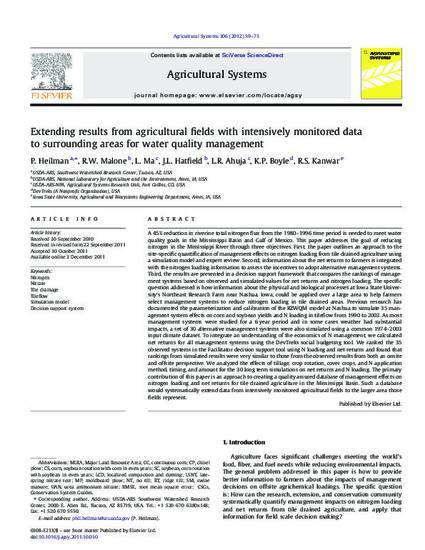
A 45% reduction in riverine total nitrogen flux from the 1980–1996 time period is needed to meet water quality goals in the Mississippi Basin and Gulf of Mexico. This paper addresses the goal of reducing nitrogen in the Mississippi River through three objectives. First, the paper outlines an approach to the site-specific quantification of management effects on nitrogen loading from tile drained agriculture using a simulation model and expert review. Second, information about the net returns to farmers is integrated with the nitrogen loading information to assess the incentives to adopt alternative management systems. Third, the results are presented in a decision support framework that compares the rankings of management systems based on observed and simulated values for net returns and nitrogen loading. The specific question addressed is how information about the physical and biological processes at Iowa State University’s Northeast Research Farm near Nashua, Iowa, could be applied over a large area to help farmers select management systems to reduce nitrogen loading in tile drained areas. Previous research has documented the parameterization and calibration of the RZWQM model at Nashua to simulate 35 management system effects on corn and soybean yields and N loading in tileflow from 1990 to 2003. As most management systems were studied for a 6 year period and in some cases weather had substantial impacts, a set of 30 alternative management systems were also simulated using a common 1974–2003 input climate dataset. To integrate an understanding of the economics of N management, we calculated net returns for all management systems using the DevTreks social budgeting tool. We ranked the 35 observed systems in the Facilitator decision support tool using N loading and net returns and found that rankings from simulated results were very similar to those from the observed results from both an onsite and offsite perspective. We analyzed the effects of tillage, crop rotation, cover crops, and N application method, timing, and amount for the 30 long term simulations on net returns and N loading. The primary contribution of this paper is an approach to creating a quality assured database of management effects on nitrogen loading and net returns for tile drained agriculture in the Mississippi Basin. Such a database would systematically extend data from intensively monitored agricultural fields to the larger area those fields represent.
Available at: http://works.bepress.com/rskanwar/89/

This article is from Agricultural Systems 106 (2012): 59–71, doi:10.1016/j.agsy.2011.10.010.